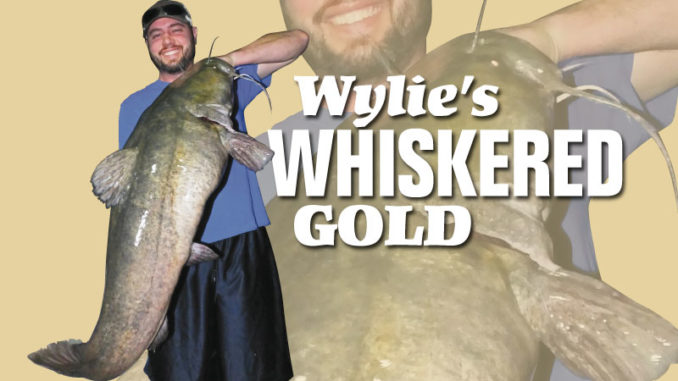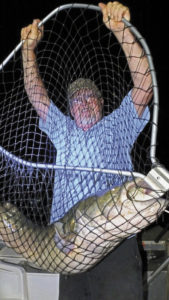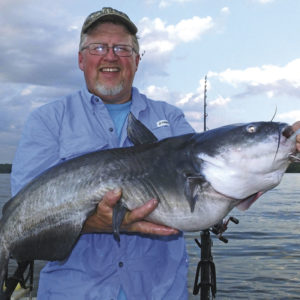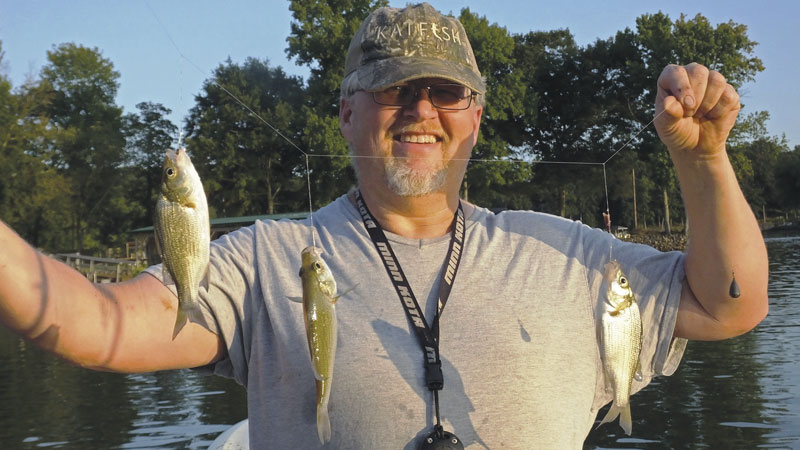
After-dark catfish action can heat up even the most-sweltering summer night — if you know how to find and catch them.
Lake Wylie provides a diverse, year-round catfishing resource for North Carolina and South Carolina anglers. All three of the major species — channels, blues and flatheads — are found in good numbers.
But summer has historically been a prime time for great catfishing opportunities. And with the right game plan, anglers can beat the summer doldrums 24 hours a day.
Jeff Manning and Michael Paciocco, both of Gastonia, N.C., are fishing buddies and partners in catfish tournaments who make Lake Wylie and its 13,400 acres on the Catawba River their home waters.
Manning said August fishing is excellent. But he’s found that targeting catfish at the right time and in specific places will enhance odds of success.
“All three species can be taken day or night. But to improve my odds of hooking quality fish, I often fish at night during the summer,” Manning said. “I have multiple reasons, including a much-more comfortable temperature, and far fewer pleasure boaters on the lake. And generally, the big catfish are more active in shallower water.”
Blues and flatheads are often in the same spots
Manning said targeting big blues and flatheads at night makes a good game plan because they can often be found on the same types of bottom topography. And the same baits work for both.
Paciocco said live baits are celebrated as a prime offering for flatheads. But these big-headed brutes are also frequently hooked on fresh cut bait.
“We catch a lot of big flatheads on cut bait, but typically it needs to be very fresh. So we catch and keep bait alive in our bait tank until we’re ready to hook it up whether live or cut,” he said. “We’ve also learned live bait will trigger plenty of big blues as well as flatheads. A big, blue catfish is not going to shy away from a live, wiggling 8-inch white perch.”
Paciocco said Lake Wylie has a strong flathead population, and it’s not just a summer fishery. He and Manning have won big tournaments in cold weather, weighing in only flatheads at Lake Wylie. But overall, the hours after dark are the most dependable of the year for big, summer flatheads.
Proper anchoring is key to catfish success
“For blues and flatheads at night we’ll target shallower water features, but we’ll have deep water nearby,” he said. “We primarily anchor fish at night because the targets are quite specific. And with the right setup, we can cover them better from an anchored position.”

He said top places include high spots or humps adjacent to the main-river channel, and points and ledges that drop into the channel. Large flats adjacent to deep water where baitfish congregate at night are also good spots.
In addition, not all catfish roam the shallows at night.
“We’ll also anchor in shallow water and fish deeper holes in the river and large tributaries,” he said.
Manning said proper anchoring is crucial for success, day or night. He locates a target on his graph and figures any wind and current into his anchor setup to ensure his bait presentation is correct.
“Never anchor on the spot you target for fishing,” he said. “I’ll factor in wind and current and anchor so I can cast baits to those places using any current or wind to enhance bait presentation. I want the baits to be downwind or downcurrent as much as possible. I anchor the boat with a long rope from one end. And I use a very heavy anchor off the other to hold the boat steady. Then, I can cast in multiple directions without lines crossing and effectively cover a lot of water.”
Numerous baitfish work well on Lake Wylie’s catfish
Manning said baits are a personal choice. But white perch is a favorite because they’re found in Lake Wylie in huge numbers. They also are a favored forage for both blues and flatheads. But gizzard shad, bream and other live baits will produce plenty of catfish. On any given trip, day or night, he’ll mix in both live and cut-bait offerings of perch, bream and shad.
“Size of bait can make a difference, so I use all sizes,” he said. “I’ve caught huge blues and flatheads on tiny and huge baits. So I don’t try to pre-determine what they’ll prefer. I’ll just give them a smorgasbord. If we observe a specific pattern on a given night we’ll certainly go with that.”
Manning said they’ll often catch channel catfish using the smaller baits, and it’s not unusual to catch the “catfish slam” all in one summer evening on Wylie.
“The lake has a good population of channel catfish, and they can be targeted in similar areas using smaller rigs and bait sizes,” he said. “Michael and I usually prefer to target big cats.”
Be patient, but don’t waste time in unproductive areas
Paciocco said they’ll give a spot an hour or more to produce before changing locations, but they won’t stay more than 90 minutes without some action.

“We’ve found several places over the years that are reasonably dependable. But nothing is a given on any trip,” he said. “We’ll move if the action is slow, because we know somewhere, and at some time, the fish are going to get on a strong bite. So moving is just part of the fish-finding process.”
Manning said daytime fishing is very similar in terms of anchoring up, except the setups are usually on deeper targets, such as the base of drops and on the deeper side of humps. But the anchoring and bait-selection process remain the same.
He said drift fishing is also very popular and is effective by day or night. But most fishermen seem to prefer drift-fishing during the day.
“During the summer, some recreational boating traffic still occurs at night. So that’s one consideration for me not to drift,” he said. “But during the day, the fish are also more likely to be scattered over larger areas. So drift-fishing can be a prime way to effectively cover more water. I tend to be partial to anchoring, but most fishermen will drift-fish with a Santee rig (a Carolina rig with a small float between the swivel and hook). And it produces excellent results.”
Catching bait is a fun part of the process
Veteran anglers Jeff Manning and Michael Paciocco not only enjoy catching big catfish during the summer, they also enjoy the process of catching bait.
Manning uses a double- or triple-hook rig and searches late in the afternoon the back of creeks and coves where perch are often feasting on schools of young-of-the-year shad.
“Fishing around shad minnows is the key to catching bait for catfish,” he said. “Using my graph, I’ll spot shad schools with perch marked under and around them. But we’ll often see shad dimpling the water, and that’s a prime target, too. I keep things simple in most of my fishing. I just get a box or two of red worms and put a small sinker on the bottom of a light-tackle rig and two or three No. 6 hooks spaced about a foot apart up the line.”
Catching a pile of bait perch is quick and easy
Manning uses his electric motor to move around flats in depths typically ranging from 8 to 15 feet until he finds a concentration of perch. When he does, most everyone will be hooking multiple fish on each drop. And it doesn’t take long to have plenty of bait. Using red worms as bait usually means some bream will be caught as well. So along with any gizzard shad he brings, he’ll have an excellent selection of bait.
“As a bonus, white perch are excellent-eating fish, and occasionally ‘keeper’ white perch are caught,” he said. “If the big catfish don’t eat them, the larger ones make the trip home at the end of the night and join us for dinner one evening. Sometimes, I’m accused of lingering too long catching bait perch because I enjoy it. The fast action is so much fun, I almost hate to quit.”
As the sun begins to set, he said someone in the boat typically reminds him it’s time to trade up from perch for 40-pound flatheads and blue catfish. But he will try to hook one last “double” before he winds up the perch rig.

DESTINATION INFORMATION
HOW TO GET THERE — Lake Wylie lies roughly between Charlotte, N.C., and Rock Hill., S.C. Three interstates — I-77, I-85 and I-485 — provide good access to the lake. The Buster Boyd Access Area on the west end of the NC 49 bridge is popular with anglers and offers a four-lane ramp and plenty of parking at the lake’s midpoint, close to food and fuel. Copperhead Access Area offers three ramps near the east side of the bridge. Closer to the dam, choose from public access sites in Big Allison and Nivens creeks.
WHEN TO GO — Hit the lake in the afternoon, giving yourself plenty of time to catch bream, white perch and shad for bait. Start targeting catfish after dark. The best after-dark action begins in July and will run through September.
BEST TECHNIQUES — Anchor up and present live and fresh cut bait to catfish around depth changes on the main lake and main creek channels.
FISHING INFO/GUIDES — Jerry Neeley, Carolinas Fishing Guide Service, 704-678-1034, www.carolinasfishing.com; Rodger Taylor, Catfish On Guide Service, 803 517-7828, www.catfishon.com. See also Guides & Charters in Classifieds.
ACCOMMODATIONS — Accommodations are plentiful in any direction from the lake. Visit www.charlottesgotalot.com; www.visitgaston.org; www.yorkcounty.gov/tourism.
MAPS — Fishing Hot Spot, 800-All-MAPS, www.fishinghotspots.com; Kingfisher Maps, 800-326-0257, www.kfmaps.com; Duke Energy, www.duke-energy.com/pdfs/wylie.pdf.

